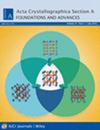Platonic solids generate their four-dimensional analogues.
IF 1.8
4区 材料科学
Acta Crystallographica Section A
Pub Date : 2013-11-01
Epub Date: 2013-09-12
DOI:10.1107/S0108767313021442
引用次数: 15
Abstract
This paper shows how regular convex 4-polytopes - the analogues of the Platonic solids in four dimensions - can be constructed from three-dimensional considerations concerning the Platonic solids alone. Via the Cartan-Dieudonné theorem, the reflective symmetries of the Platonic solids generate rotations. In a Clifford algebra framework, the space of spinors generating such three-dimensional rotations has a natural four-dimensional Euclidean structure. The spinors arising from the Platonic solids can thus in turn be interpreted as vertices in four-dimensional space, giving a simple construction of the four-dimensional polytopes 16-cell, 24-cell, the F4 root system and the 600-cell. In particular, these polytopes have `mysterious' symmetries, that are almost trivial when seen from the three-dimensional spinorial point of view. In fact, all these induced polytopes are also known to be root systems and thus generate rank-4 Coxeter groups, which can be shown to be a general property of the spinor construction. These considerations thus also apply to other root systems such as A(1)\oplus I(2)(n) which induces I(2)(n)\oplus I(2)(n), explaining the existence of the grand antiprism and the snub 24-cell, as well as their symmetries. These results are discussed in the wider mathematical context of Arnold's trinities and the McKay correspondence. These results are thus a novel link between the geometries of three and four dimensions, with interesting potential applications on both sides of the correspondence, to real three-dimensional systems with polyhedral symmetries such as (quasi)crystals and viruses, as well as four-dimensional geometries arising for instance in Grand Unified Theories and string and M-theory.柏拉图立体生成它们的四维类似物。
本文展示了正则凸4-多面体——四维柏拉图立体的类似物——如何从仅关于柏拉图立体的三维考虑中构造出来。通过cartan - dieudonn定理,柏拉图立体的反射对称性产生旋转。在Clifford代数框架中,产生三维旋转的旋量空间具有自然的四维欧几里得结构。从柏拉图立体中产生的旋量可以反过来被解释为四维空间中的顶点,给出了一个简单的四维多面体16细胞,24细胞,F4根系和600细胞的结构。特别是,这些多面体具有“神秘的”对称性,从三维旋体的角度来看,这些对称性几乎微不足道。事实上,所有这些诱导的多构体也都是根系,因此产生了4级Coxeter群,这可以被证明是旋体结构的一般性质。因此,这些考虑也适用于其他根系,如A(1)\oplus I(2)(n),它诱导I(2)(n)\oplus I(2)(n),解释了大反棱镜和弱24细胞的存在,以及它们的对称性。这些结果在阿诺德三位一体和麦凯对应的更广泛的数学背景下进行了讨论。因此,这些结果在三维和四维几何之间建立了一种新的联系,在对应的两边都有有趣的潜在应用,可以应用于具有多面体对称性的实际三维系统,如(准)晶体和病毒,以及在大统一理论、弦和m理论中出现的四维几何。
本文章由计算机程序翻译,如有差异,请以英文原文为准。
求助全文
约1分钟内获得全文
求助全文
来源期刊
自引率
11.10%
发文量
0
审稿时长
3 months
期刊介绍:
Acta Crystallographica Section A: Foundations and Advances publishes articles reporting advances in the theory and practice of all areas of crystallography in the broadest sense. As well as traditional crystallography, this includes nanocrystals, metacrystals, amorphous materials, quasicrystals, synchrotron and XFEL studies, coherent scattering, diffraction imaging, time-resolved studies and the structure of strain and defects in materials.
The journal has two parts, a rapid-publication Advances section and the traditional Foundations section. Articles for the Advances section are of particularly high value and impact. They receive expedited treatment and may be highlighted by an accompanying scientific commentary article and a press release. Further details are given in the November 2013 Editorial.
The central themes of the journal are, on the one hand, experimental and theoretical studies of the properties and arrangements of atoms, ions and molecules in condensed matter, periodic, quasiperiodic or amorphous, ideal or real, and, on the other, the theoretical and experimental aspects of the various methods to determine these properties and arrangements.

 求助内容:
求助内容: 应助结果提醒方式:
应助结果提醒方式:


